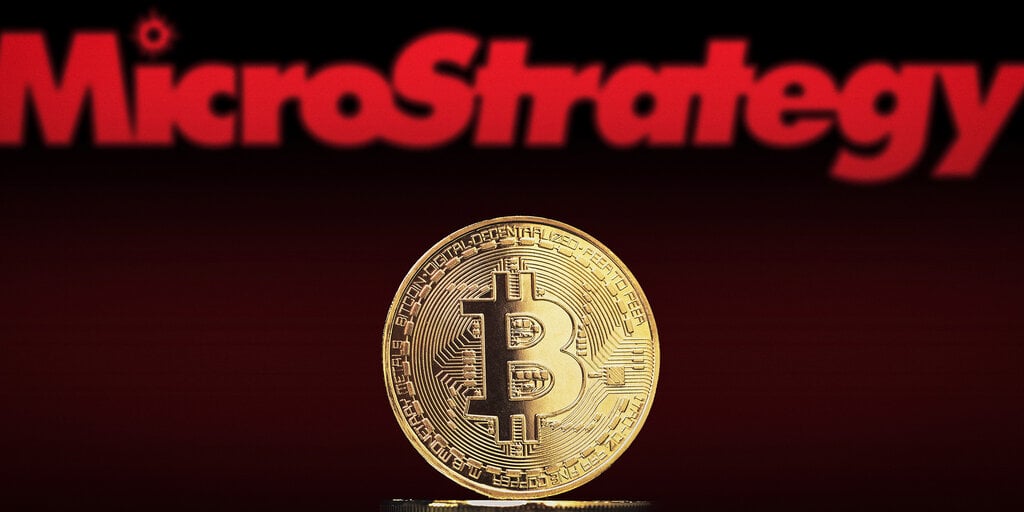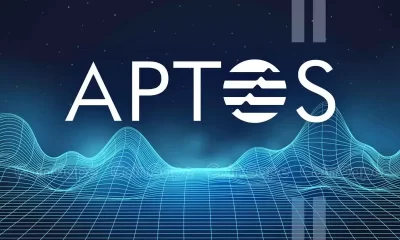business
MicroStrategy Just Bought Another $4.6 Billion Worth of Bitcoin
Published
5 months agoon
By
admin

MicroStrategy, a software firm founded by Michael Saylor, disclosed Monday morning that it has bought another 51,780 Bitcoin at an average price of $88,627, totaling $4.6 billion, according to an SEC filing.
As he always does, the company’s Executive Chairman, Saylor, boasted about the purchase on Twitter by noting that the company’s holdings now total 331,200 Bitcoin. The software company’s Bitcoin stash was acquired for $16.5 billion in total, but thanks to the recent price rally, it’s now worth almost double that at $29.65 billion.
MicroStrategy has acquired 51,780 BTC for ~$4.6 billion at ~$88,627 per #bitcoin and has achieved BTC Yield of 20.4% QTD and 41.8% YTD. As of 11/17/2024, we hodl 331,200 $BTC acquired for ~$16.5 billion at ~$49,874 per bitcoin. $MSTR https://t.co/SRRtRrB2jO
— Michael Saylor
(@saylor) November 18, 2024
The latest move comes after the firm purchased $2 billion Bitcoin just last week, at an average price of $74,463. Combined, that means MicroStrategy has bought 51,780 Bitcoin over the past seven days.
For perspective: This figure is twice the global Bitcoin exchange-traded product (ETP) inflow over the past week, according to Vetle Lunde, Head of Research at K33Research.
MicroStrategy added 51,780 BTC last week!!!
That’s just crazy. It’s a figure twice the global BTC ETP inflow over the past week of 25,993 BTC. pic.twitter.com/IHjJ0ub1si
— Vetle Lunde (@VetleLunde) November 18, 2024
Bitcoin’s price has been surging since Donald Trump secured a second term as President of the United States. The pro-crypto candidate has made a range of promises to the industry, from creating a strategic Bitcoin reserve to firing SEC Chair Gary Gensler.
The orange coin has broken its all-time high price mark multiple times over the past two weeks, with its latest peak being $93,477, according to CoinGecko. With this, MicroStrategy’s stock price also hit an all-time high, surpassing a market capitalization of $69 billion last week, thanks to the firm stockpiling Bitcoin.
Last week, according to Google Finance, MSTR traded at a peak of $383 and has since fallen to a current price of about $350. Meanwhile, Bitcoin has risen by nearly 11% over the past 7 days to a current price of $90,765.
Founded in 1989, MicroStrategy was originally a data intelligence software company. However, in 2020, the firm bought $250 million worth of Bitcoin as Saylor looked to spice up the company’s books during the pandemic.
Since then, the firm’s destiny has been closely tied with Bitcoin, with MicroStrategy even rebranding itself as a Bitcoin development company. In October, MicroStrategy outlined a plan to purchase $42 billion worth of Bitcoin over the next three years.
Saylor has set jaw-droppingly bullish targets for Bitcoin. In September, the firm’s founder predicted that Bitcoin would rise to a price of $13 million per coin over the next 21 years. From today’s price, that would represent a 14,222% increase.
These targets help explain why MicroStrategy has continued to acquire Bitcoin amid its recent pump, despite the firm already being the public company with the largest Bitcoin holding with more than 1% of the total supply.
Edited by Stacy Elliott and Andrew Hayward
Daily Debrief Newsletter
Start every day with the top news stories right now, plus original features, a podcast, videos and more.
Source link
You may like


Futureverse Acquires Candy Digital, Taps DC Comics and Netflix IP to Boost Metaverse Strategy


Court Grants Ripple And SEC’s Joint Motion To Suspend Appeal


AVAX Falls 2.1% as Nearly All Assets Trade Lower


What is a VTuber, and how do you become one in 2025?


Top Expert’s Update Sets $10 Target


How Academia Interacts With The Bitcoin Ecosystem
business
Strategy Buys More Bitcoin as Tariff Exemptions Send Tech Stocks Soaring
Published
2 days agoon
April 14, 2025By
admin

Strategy, formerly known as MicroStrategy, acquired around 3,450 Bitcoin worth $286 million last week, the company said in a Securities and Exchange Commission filing.
Unveiling a Bitcoin purchase for the third straight Monday, the Tysons, Virginia-based firm now owns 531,644 Bitcoin worth $45.2 billion, based on the asset’s current price.Strategy paid an average price of $82,600 per Bitcoin last week, it added.
Strategy, which has shifted its focus from software development to become a Bitcoin treasury, said it meanwhile sold one million Class A common shares through an at-the-money offering program unveiled in October. Under the initiative, Strategy said it can still issue an additional $2 billion worth of common shares, alongside swaths of preferred perpetual stock.
Strategy’s shares rose 4% on Monday to around $312, as the tech-heavy Nasdaq surged 1.5%, adding on to last week’s recovery after the White House said smartphones and computers would be exempt from sweeping levies, including 125% taxes on Chinese goods, per Nasdaq.
Monday’s price action represents a dramatic turnaround after investors navigated outsized uncertainty last week, including a disclosure from Strategy that it may ultimately need to sell Bitcoin to meet its financial obligations. Amid tariff-linked concerns, Strategy’s shares fell as low as $236, or around 32% below their opening on Monday.
“No Tariffs on Orange Dots,” Strategy co-founder and Executive Chairman Michael Saylor said on X, formerly Twitter, on Sunday, referring to the way Bitcoin buys look on Saylor Tracker.
The price of Bitcoin was recently changing hands around $85 on Monday, showing a roughly 8.3% increase of the past week, according to CoinGecko. Over the past month, it’s virtually flat.
Strategy has become the world’s largest corporate holder of Bitcoin since it began accumulating the asset in 2020. Over time, as it has embraced its role as a Bitcoin treasury firm, Strategy has issued billions of dollars in debt to buy more Bitcoin than it could otherwise.
The Nasdaq-listed firm’s 531,600 Bitcoin tower over the next largest corporate holder, Bitcoin miner Marathon Digital, which is around 47,500 Bitcoin, according to Bitcoin Treasures. As of this writing, Strategy’s stash accounted for more than 2.5% of Bitcoin total supply.
The Tokyo-based investment firm Metaplanet, which began buying Bitcoin last May, said on X on Monday that it had recently bought 319 Bitcoin worth $27 million. The company said in an update that it now holds 4,525 Bitcoin worth around $385 million.
Among publicly traded companies, MetaPlanet is currently the 10th largest Bitcoin holder, according to Bitcoin Treasuries.
Edited by James Rubin
Daily Debrief Newsletter
Start every day with the top news stories right now, plus original features, a podcast, videos and more.
Source link
business
Japan’s Metaplanet Buys Another $26M in Bitcoin Amid Tariff Market Uncertainty
Published
2 days agoon
April 14, 2025By
admin

Metaplanet, the Tokyo-listed firm dubbed “Asia’s MicroStrategy,” has boosted its Bitcoin holdings with a fresh 3.78 billion yen ($26.3 million) purchase amid growing tension over U.S. trade tariffs.
The company said it acquired 319 BTC at an average price of 12,849,780 yen ($82,549) per coin, bringing its total holdings to 4,525 BTC. Metaplanet plans to boost its Bitcoin holdings by 470%, targeting a total of 10,000 BTC by year-end.
The timing of the purchase comes as digital assets falter under geopolitical pressure. Bitcoin dropped more than 2% on Sunday during Asia trading hours, sliding to $83,482 as investors digested conflicting signals from Washington over the direction of U.S. trade policy toward China.
Traditional markets remained resilient despite a flurry of comments from the Trump administration regarding new tariffs on Chinese electronics. Nasdaq 100 futures rose over 1% in early trading, while S&P 500 futures climbed 0.7%.
While smartphones and semiconductors were temporarily excluded from a proposed 10% “reciprocal” tariff, President Trump clarified late Sunday on Truth Social that the same products will remain subject to a separate 20% national security levy.
Commerce Secretary Howard Lutnick said further sector-specific tariffs are expected within the next two months.
By Monday, 1 a.m. ET, Bitcoin was up just 0.4% over the last 24 hours, trading at $84,990, according to CoinGecko. Ether was up 1.8% to $1,638 over the same period. The top ten cryptocurrencies by market cap have all posted slight gains or no change.
Metaplanet has leaned heavily into Bitcoin as its core treasury asset. Last month, the company appointed Eric Trump, son of the U.S. president, to its newly formed Strategic Advisory Board, citing his “business expertise and passion for Bitcoin.”
Metaplanet is positioning itself in the mold of Michael Saylor’s Strategy, whose aggressive Bitcoin accumulation strategy has influenced a growing number of publicly listed firms to follow suit.
At the same time, the Trump administration has launched two separate initiatives: a Strategic Bitcoin Reserve, funded by seized BTC and held as a permanent national asset, and a U.S. Digital Asset Stockpile, which includes other confiscated crypto with potential for liquidation or strategic use.
Edited by Sebastian Sinclair
Daily Debrief Newsletter
Start every day with the top news stories right now, plus original features, a podcast, videos and more.
Source link
business
Scottish School Will Accept Bitcoin Payments, May Launch BTC Reserve
Published
4 days agoon
April 12, 2025By
admin

A school in Scotland has said it will be the first in the UK to start accepting Bitcoin payments.
Lomond School in the town of Helensburgh said that it made the choice to accept the cryptocurrency after a number of parents—both local and foreign—made the request, The Times reported.
The private boarding school has a number of international students.
To “manage and mitigate risk,” the school said it would start accepting the biggest cryptocurrency in phases, and would convert digital coins received into pound sterling. It also said that it would ensure full compliance with UK financial regulations when accepting BTC.
The school added that it would also consider building a reserve of the cryptocurrency if its use case grows in the UK. “Assuming Bitcoin gains broader acceptance in the UK and worldwide, the school will look to build a Bitcoin asset reserve,” it said in a statement.
Lomond School did not immediately respond to Decrypt’s questions.
The idea of a “Bitcoin asset reserve” echoes U.S. President Trump’s executive order signed last month authorizing the government to hold BTC and figure out ways to buy more of the asset. The U.S. government already holds around 200,000 BTC—worth $16.7 billion at today’s price—that was primarily seized or forfeited in criminal cases.
A number of other countries are now considering holding Bitcoin—like they hold other assets in reserves—and businesses too have started buying up the asset. Strategy, the largest corporate holder of Bitcoin, currently holds over $44 billion worth of the asset.
Edited by Andrew Hayward
Daily Debrief Newsletter
Start every day with the top news stories right now, plus original features, a podcast, videos and more.
Source link

Futureverse Acquires Candy Digital, Taps DC Comics and Netflix IP to Boost Metaverse Strategy
Court Grants Ripple And SEC’s Joint Motion To Suspend Appeal

AVAX Falls 2.1% as Nearly All Assets Trade Lower

What is a VTuber, and how do you become one in 2025?

Top Expert’s Update Sets $10 Target

How Academia Interacts With The Bitcoin Ecosystem

AB DAO and Bitget Launch Dual Reward Campaign, Distributing $2.6M Worth of $AB Globally

AI crypto tokens at risk as Nvidia faces restrictions on China exports

Coinbase Urges Australia to Vote for Crypto Progress in May

How High Would Pi Network Price Go If Pi Coin Adopts Transparency to Avoid Mantra Pitfalls

XRP’s ‘Rising Wedge’ Breakdown Puts Focus on $1.6 Price Support

China selling seized crypto to top up coffers as economy slows: Report

Ethereum Price Dips Again—Time to Panic or Opportunity to Buy?

The Inverse Of Clown World”

Bitcoin Indicator Flashing Bullish for First Time in 18 Weeks, Says Analyst Who Called May 2021 Crypto Collapse

Arthur Hayes, Murad’s Prediction For Meme Coins, AI & DeFi Coins For 2025

Expert Sees Bitcoin Dipping To $50K While Bullish Signs Persist

Aptos Leverages Chainlink To Enhance Scalability and Data Access

Bitcoin Could Rally to $80,000 on the Eve of US Elections

Crypto’s Big Trump Gamble Is Risky

Sonic Now ‘Golden Standard’ of Layer-2s After Scaling Transactions to 16,000+ per Second, Says Andre Cronje

Institutional Investors Go All In on Crypto as 57% Plan to Boost Allocations as Bull Run Heats Up, Sygnum Survey Reveals

Ripple-SEC Case Ends, But These 3 Rivals Could Jump 500x

3 Voting Polls Show Why Ripple’s XRP Price Could Hit $10 Soon

Has The Bitcoin Price Already Peaked?

A16z-backed Espresso announces mainnet launch of core product

The Future of Bitcoin: Scaling, Institutional Adoption, and Strategic Reserves with Rich Rines

Xmas Altcoin Rally Insights by BNM Agent I

Blockchain groups challenge new broker reporting rule

I’m Grateful for Trump’s Embrace of Bitcoin
Trending

 24/7 Cryptocurrency News5 months ago
24/7 Cryptocurrency News5 months agoArthur Hayes, Murad’s Prediction For Meme Coins, AI & DeFi Coins For 2025

 Bitcoin3 months ago
Bitcoin3 months agoExpert Sees Bitcoin Dipping To $50K While Bullish Signs Persist

 24/7 Cryptocurrency News3 months ago
24/7 Cryptocurrency News3 months agoAptos Leverages Chainlink To Enhance Scalability and Data Access

 Bitcoin5 months ago
Bitcoin5 months agoBitcoin Could Rally to $80,000 on the Eve of US Elections

 Opinion5 months ago
Opinion5 months agoCrypto’s Big Trump Gamble Is Risky

 Altcoins3 months ago
Altcoins3 months agoSonic Now ‘Golden Standard’ of Layer-2s After Scaling Transactions to 16,000+ per Second, Says Andre Cronje

 Bitcoin5 months ago
Bitcoin5 months agoInstitutional Investors Go All In on Crypto as 57% Plan to Boost Allocations as Bull Run Heats Up, Sygnum Survey Reveals

 Price analysis5 months ago
Price analysis5 months agoRipple-SEC Case Ends, But These 3 Rivals Could Jump 500x


